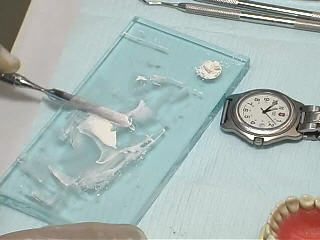
Back to Cements | Back to Operative Videos
Zinc phosphate cement the one of the oldest and widely used cements, and is commonly used for luting permanent metal restorations and as a base. It is a high-strength cement base, mixed from zinc oxide powder and phosphoric acid liquid. Due to its low initial pH, it may cause pulpal irritation, especially where only a thin layer of dentin exists between the cement and the pulp; thus is especially important to follow the correct procedures and precautions when using zinc phosphate cement.
Right-click here to download this video.
( Choose the "Save As ..." option from the menu.)
Carefully shake the powder to evenly distribute the contents. First, fill approximately
three-quarters of the tip of the cap—as indicated by the red mark—and
place the powder onto the lower right corner of the glass slab (for left-handed
operators, place in lower left corner of the glass).
Then refill the entire tip portion of the cap with powder and place this measure
in the upper right corner of the glass slab (for left-handed operators, place
in upper left corner of the glass).
Before dispensing the liquid, divide the first, smaller measure of powder into six even portions. Carefully shake the liquid and, holding the bottle 90 degrees to the glass slab, dispense six drops in the center of the slab.
Mix each of the six portions of the powder in one at a time; after these have been added, the mixture should produce about a 1 inch “string” when stretching the mixture up with a spatula. (This consistency is used for cementation of inlays, onlays and crowns.)
Add the additional powder from the upper corner of the glass into the mixture as necessary, mixing for about two minutes. The final mixture should be putty-like; it should be tacky but malleable, and stiff enough to be properly condensed when placed.
Roll the mixed cement into a long roll and cut it into small pieces using the spatula.
Using the large condenser, pick up a piece and place it into the prepared cavity and lightly condense; the cement should be placed up to 0.5 mm short of the DEJ. Be sure not to contaminate the walls of the cavity. Carefully remove any excess cement.
Back to Cements | Back to Operative Videos